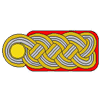With the palm trees, I have followed Luke Towan's method. My brother in law is a sparky so I easily sourced some 2.7mm solid core wire for the basis of the trunks. I stripped off about 1.5cm (19/32") off the bottom. Florists wire was wrapped around irregularly creating ridges with gaps in between.
The leaves were downloaded from his website and I went for both palm tree fronds as well as a fan version as well. Some time ago I bought the better half to a Cricut machine which was perfect for cutting the fronds. I found that the cricut didn't need the addition of self adhesive plastic, instead using card from the wife's stash - 216 gsm. Some of the fan leaves tore a bit, but this seemed to be dependant on the colour of the card (all same brand). If you don't have access to a cutting machine, you could hand cut if you have the patience of a saint!

Florist wire was attached to the underside of each frond to provide some rigidity. Since I had some latex (more on that later) I used that to coat the tree trunks. Hopefully that should allow the trunks to bent into the desired shape later. Airdry clay was used to model the 'bulb' at the top of the trunk. I couldn't decide on the right colour for the trunks, overpainting several times. Eventually I settled on Tamiya JDSDF Brown (XF-72) with a darker wash over the top. Using a google search of palms trees as a reference, the colours of the trunks seem to vary with shade, sunlight and exposure of the photo. Ultimately I would've filled all the cracks with paint if I'd kept going, but would probably go lighter in future. I then used hessian twine tweezed apart and attached to the top of the trunk. I had some Hob-e-Tac glue from the Woodland Scenics tree making learning kit which worked well.

Because I used card available to me, base colour of each frond was different. I was most happy with the second palm tree fronds I did, having refined the process a little better. I can't remember the exact mix I used now (5:2 I think), but I mixed Tamiya deep green (XF-26) with yellow green (XF-4) to airbrush the outer half of the frond. A mix with a little more deep green was airbrushed onto the centre. I then hand brushed Tamiya buff (XF-57) onto the frond tips. With hindsight I would use this approach for the fan palms particularly, as the wide main part of the frond would benefit from a little more tonal variation.

I attached the fronds using CA glue. The fronds were bent slightly to shape them and then the tips and sides of the fronds brushed randomly using fingertips to give a more natural look. You can't see on the below photo, but I also added coconuts made from airdry clay. I'm really happy with the way these came out. Luke Towan's tutorial can be found on his youtube channel.








































